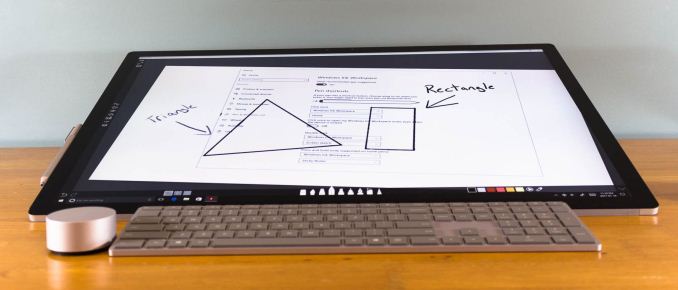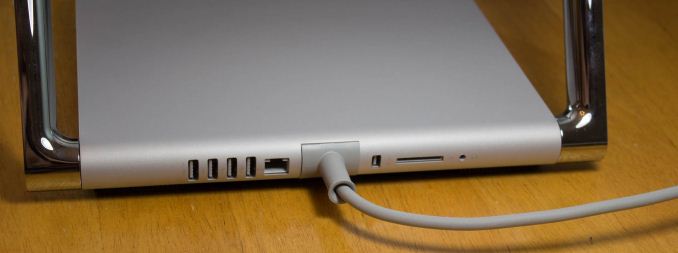The Microsoft Surface Studio Review
by Brett Howse on January 20, 2017 8:00 AM EST- Posted in
- Desktop
- Microsoft
- Surface
- Surface Studio
Design and the Zero-Gravity Hinge
Microsoft has built a brand around Surface, and that’s not an easy thing to accomplish. The Surface Studio fits in very well with the design ethos of the rest of the Surface lineup, and there has been quite a bit of attention to details paid in the creation of their first desktop computer. The first, and most obvious, is the finish, which matches perfectly with the other Surface devices, despite being made from aluminum rather than the magnesium alloy used on the portable products.
The 3:2 aspect ratio of the Surface Studio display is now a hallmark of the Surface brand (outside of Surface Hub), and having a taller display makes doing most tasks on a desktop a more pleasant experience. The increased surface area can’t be forgotten either, with the Surface Studio offering 17% more screen real estate than what's arguably the Studio's closest competitor, the 27-inch iMac, which amounts to an additional 54 square inches of display. Widescreen at 16:9 has never been a great aspect ratio for PC tasks, but the proliferation of high definition television seems to have moved the entire industry this way in an effort to save costs. When looking at the price of the Surface Studio, it’s important to remember that the entire display industry has moved to 16:9 as a standard, which impacts the entire supply chain and tooling required. Moving to an aspect ratio outside of 16:9 has large cost implications, but the end results are certainly worth it. Hopefully we will see a few other manufacturers use this as a means to source displays like this, much like the Surface Pro 3 and Pro 4 have ushered in more 3:2 devices at that much smaller size. And speaking of attention to detail, the Surface Studio is actually 28.125-inches diagonal, and as we'll see in a bit, that last 0.125-inches is very important.
It seems with Surface, Microsoft always wants to have a trick up their sleeve. With the original Surface RT and Surface Pro, it was the kickstand, which has been adopted by quite a few manufacturers for their own device since it works so well. When they launched their first laptop, the Surface Book, it was the muscle wire locking mechanism to remove the display from the base, as well as the dynamic fulcrum hinge to make the top-heavy laptop more stable. With the Surface Studio, the zero-gravity hinge is most definitely its signature design feature.
With two chrome arms flanking the base, the Surface Studio can almost effortlessly be folded down into a drafting table. The hinge mechanism provides a perfect counterbalance to the weight of the display, making it feel like it has almost no weight at all. The hinge is a single movement as well, so you don’t tip and fold the screen, but instead folding the screen also causes it to move down. While this does limit the functionality somewhat – for instance, you can't move the screen half way down and then fold it up straight again – the result is truly a wonderful design which almost needs to be seen in person.
Because you can’t tip the screen without folding it, once you stop at any angle, the screen is very solid to work with, although it is the most secure when folded all the way down to the 20° angle. You would think a large desktop display would not be ideal to use with touch, but the Surface Studio zero-gravity hinge invites you to be more interactive with it, by keeping the display close and folding it down when needed. More traditional all-in-one computers with a touch screen are nowhere near as easy to work with, since holding your arm in dead-air can be tiring, but the folded display doesn’t suffer from these burdens.
The PC base also exudes Surface quality, with the signature color, and cooling vents all the way around in the same fashion as the Surface Pro and Surface Book. The PC base can be disassembled from the bottom if required, for access to the storage and fans, but the remainder of the system is soldered to the board as you would expect in a small form factor device like this. The most frustrating part of the Surface Studio base is that all the inputs and outputs are on the rear of the device, so connecting something over USB, or inserting a SD card into the PC, is not as simple as it should be. This is a form over function decision, and it would be nice to see some of the ports offered at least on the side of the base to make it a bit easier to access.
The desktop PC market has not been as exciting to watch as the smaller and more portable laptops and tablets, but the Surface Studio sets a new high mark for desktop PC design and looks. Some of the decisions are form over function, but the majority of the design decisions actually improve the user experience. The zero-gravity hinge is a masterpiece of engineering, with such a smooth action that it really does feel like the display has no mass at all.













197 Comments
View All Comments
Sttm - Friday, January 20, 2017 - link
I can't rationalize a need for this product, and I really can't rationalize buying one, but I look at it and I love it. Hopefully by the 3rd generation they can get the price down to $1500, and I can buy one for the sake of having it.disappointed_reader - Friday, January 20, 2017 - link
As a long-time reader and fan of AnandTech, I am incredibly disappointed in this review. No display expert would ever recommend targeting a gamut other than sRGB under Windows. No color management is not a trivial detail - it's a fundamental problem, and color modes are a small band-aid, not an actual solution. As even the (imperfect) sRGB testing here shows, natively targeting P3 gamut inherently compromises sRGB accuracy, which should have been Microsoft's actual target.This display is no "masterpiece" - far from it. Maybe one day a miracle will happen and Win32 can somehow add color management, but FreeSync 2 and G-Sync HDR seem like the only possible hacks that will ever reasonably work.
id4andrei - Friday, January 20, 2017 - link
I think the author was praising the actual hardware when he said masterpiece. What you are rightfully complaining about is software.jlabelle2 - Sunday, January 22, 2017 - link
I read the contrary that in each color space targeted, the calibration out of the box is too notch.It is true that it is an issue that W10 is not color managed system wide like MacOS.
But this is very clever to have the ability to switch from a toggle in the Action Center.
In day to day activities, you are in sRGB.
And when you switch to Photoshop or video editing or Capture One Pro you switch to P3-65. That is honestly a very very clever implementation in regard of the current limitation.
sorten - Friday, January 20, 2017 - link
First of all, AnandTech, thank you for the "Illegal Photos" of large breasted Asian women who apparently live in North Korea. Who knew that so many NK women could afford and have access to breast implants?Secondly, I am a big fan of the Surface Studio. I'm not in the target market, but I still want one. If I were to consider it, then it would have to have 1) some usb-c connectors, at least one with TB3 support, 2) latest graphics from NVidia or AMD, 3) latest CPU from Intel or AMD. I'm sure those points will be addressed with the refresh and were a result of the release timing not quite working out.
serendip - Saturday, January 21, 2017 - link
Whaaa... Where??? I only saw owls!The price for the base model is rather optimistic given the mobile internals. How does the pricing compare to the iMac?
fanofanand - Monday, January 23, 2017 - link
Lucky! All I get is 9 boxes telling me why I should use revcontent for my advertising (I don't own a business). I'd WAY rather take N. Korean tatas! (no I don't mean the Indian car brand)BrokenCrayons - Monday, January 23, 2017 - link
Though it's been said before, advertising these days is usually targeted based on the recorded Internet usage habits of the individual. If you're seeing those sorts of ads, maybe it's time to reconsider what you're looking at on the Internet.Meteor2 - Friday, January 20, 2017 - link
The timing seems all wrong on this thing. With the 'Creator's Update' still months away, why didn't Microsoft plan the development of their hardware so they could include Type-C, TB3, NVMe, and a 10x0 GPU, and just release it a bit closer to the software which is supposed to make the most of this device?It's like the two departments aren't talking...
Shadowmaster625 - Friday, January 20, 2017 - link
The reason everyone says "wow" when they see the display is because they are thinking "Wow, you just spent $4000 on a $1200 screen and a $1200 computer."